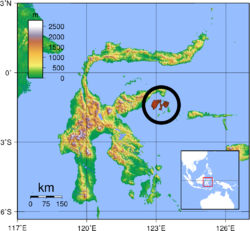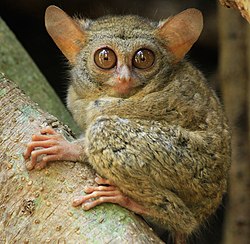Tarsius
Genus of primates From Wikipedia, the free encyclopedia
Tarsius is a genus of tarsiers, small primates native to islands of Maritime Southeast Asia, with almost all of its species found on Sulawesi Island. Until 2010, all tarsier species were typically assigned to this genus, but a revision of the family Tarsiidae restored the generic status of Cephalopachus and created a new genus Carlito.[1]
| Tarsius[1] Temporal range: Eocene to recent | |
|---|---|
 | |
| Gursky's spectral tarsier | |
| Scientific classification | |
| Domain: | Eukaryota |
| Kingdom: | Animalia |
| Phylum: | Chordata |
| Class: | Mammalia |
| Order: | Primates |
| Suborder: | Haplorhini |
| Family: | Tarsiidae |
| Genus: | Tarsius Storr, 1780 |
| Type species | |
| Lemur tarsier Erxleben, 1777 | |
| Species | |
| |
 | |
| Distribution and range of Tarsius supriatnai and other tarsier species in Sulawesi, Indonesia: | |
All members of Tarsius are found on Sulawesi, while Cephalopachus is found on Sundaland and Carlito in Greater Mindanao.
Species
Summarize
Perspective
| Common name | Scientific name and subspecies | Range | Size and ecology | IUCN status and estimated population |
|---|---|---|---|---|
| Dian's tarsier
|
T. dentatus Miller & Hollister, 1921 |
Central Sulawesi, Indonesia |
Size: 11–12 cm (4–5 in) long, plus 13–28 cm (5–11 in) tail[2][3] Habitat: Forest[4] Diet: Insects, as well as small vertebrates[2] |
VU
|
| Gursky's spectral tarsier | T. spectrumgurskyae Shekelle, Groves, Maryanto & Mittermeier, 2017 |
Northeastern Sulawesi (in purple) |
Size: About 14 cm (6 in) long, plus 21–27 cm (8–11 in) tail[5] Habitat: Forest[6] Diet: Insects, as well as small vertebrates[6] |
VU
|
| Jatna's tarsier
|
T. supriatnai Shekelle, Groves, Maryanto & Mittermeier, 2017 |
Northern Sulawesi (in gray) |
Size: About 14 cm (6 in) long, plus 23–25 cm (9–10 in) tail[5] Habitat: Forest[7] Diet: Insects, as well as small vertebrates[7] |
VU
|
| Lariang tarsier
|
T. lariang Groves & Merker, 2006 |
Central Sulawesi |
Size: About 12 cm (5 in) long, plus 12–21 cm (5–8 in) tail[8] Habitat: Forest[9] Diet: Insects, as well as small vertebrates[9] |
DD
|
| Makassar tarsier | T. fuscus Fischer von Waldheim, 1804 |
Southern Sulawesi (in yellow) |
Size: 12–13 cm (5 in) long, plus 24–26 cm (9–10 in) tail[10] Habitat: Forest and caves[11] Diet: Insects, as well as small vertebrates[10] |
VU
|
| Niemitz's tarsier
|
T. niemitzi Shekelle, Groves, Maryanto, Mittermeier, Salim & Springer, 2019 |
Northern Sulawesi (circled in black) |
Size: About 14 cm (6 in) long, plus 24–26 cm (9–10 in) tail[12] Habitat: Forest[13] Diet: Insects, as well as small vertebrates[13] |
EN
|
| Peleng tarsier
|
T. pelengensis Sody, 1949 |
Eastern Sulawesi |
Size: 12–14 cm (5–6 in) long, plus 25–27 cm (10–11 in) tail[14] Habitat: Forest[15] Diet: Insects, as well as frogs, lizards, and other small vertebrates[15] |
EN
|
| Pygmy tarsier
|
T. pumilus Miller, Hollister, 1921 |
Central Sulawesi |
Size: 8–11 cm (3–4 in) long, plus 20–21 cm (8 in) tail[16][17] Habitat: Forest[18] Diet: Arthropods and insects, as well as small vertebrates[16] |
EN
|
| Sangihe tarsier | T. sangirensis Meyer, 1897 |
Sangir Island, southeastern Philippines |
Size: 12–13 cm (5 in) long, plus about 30 cm (12 in) tail[19] Habitat: Forest and inland wetlands[20] Diet: Insects, as well as birds, lizards, and other small vertebrates[19] |
EN
|
| Siau Island tarsier | T. tumpara Shekelle, Groves, Merker & Supriatna, 2008 |
Siau Island, north of Sulawesi | Size: 10–15 cm (4–6 in) long, plus about 20 cm (8 in) tail[21] Habitat: Forest[22] Diet: Arthropods, as well as small vertebrates[22] |
CR
|
| Spectral tarsier
|
T. tarsier (Erxleben, 1777) |
Sulawesi |
Size: 9–14 cm (4–6 in) long, plus 20–26 cm (8–10 in) tail[23] Habitat: Forest[24] Diet: Insects, as well as lizards, bats, and other small vertebrates[23] |
VU
|
| Wallace's tarsier
|
T. wallacei Merker, Driller, Dahruddin, Wirdateti, Sinaga, Perwitasari-Farajallah & Shekelle, 2010 |
Northern Sulawesi (in orange) |
Size: 11–13 cm (4–5 in) long, plus 23–27 cm (9–11 in) tail[25] Habitat: Forest and inland wetlands[26] Diet: Insects, as well as small vertebrates[25] |
VU
|
As of 2018[update], Fossilworks also recognizes the following additional extinct species:[27]
References
Sources
External links
Wikiwand - on
Seamless Wikipedia browsing. On steroids.




